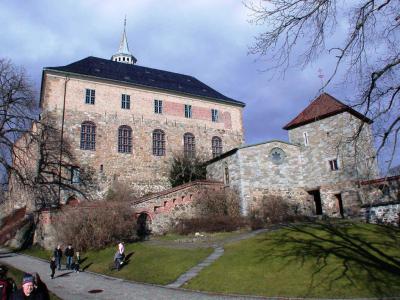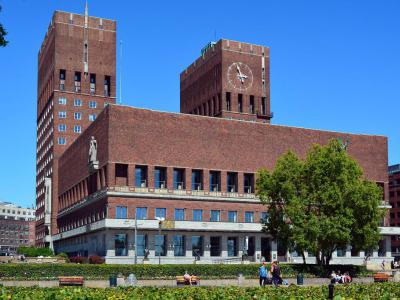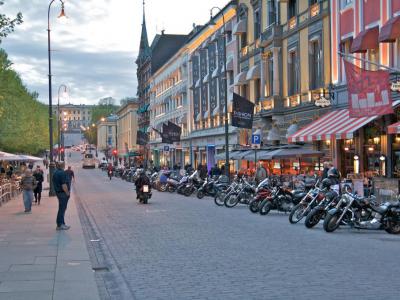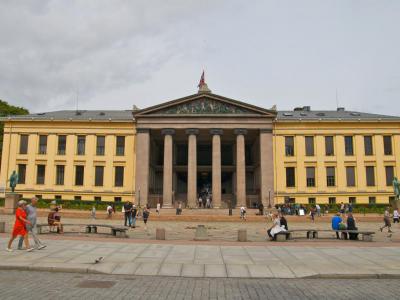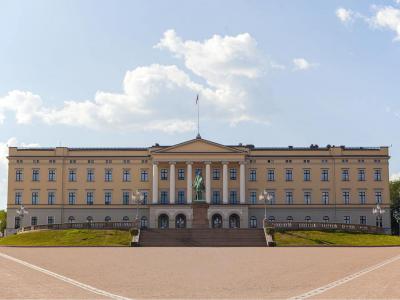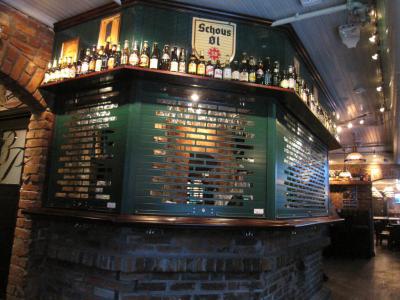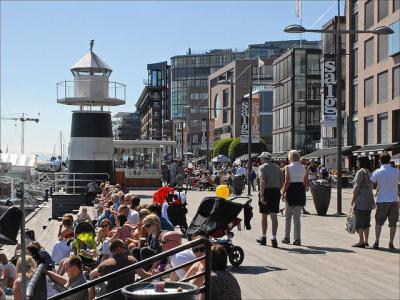Custom Walk in Oslo, Norway by clairejohn1972_54625 created on 2025-06-09
Guide Location: Norway » Oslo
Guide Type: Custom Walk
# of Sights: 7
Tour Duration: 2 Hour(s)
Travel Distance: 4.4 Km or 2.7 Miles
Share Key: L4EDF
Guide Type: Custom Walk
# of Sights: 7
Tour Duration: 2 Hour(s)
Travel Distance: 4.4 Km or 2.7 Miles
Share Key: L4EDF
How It Works
Please retrieve this walk in the GPSmyCity app. Once done, the app will guide you from one tour stop to the next as if you had a personal tour guide. If you created the walk on this website or come to the page via a link, please follow the instructions below to retrieve the walk in the app.
Retrieve This Walk in App
Step 1. Download the app "GPSmyCity: Walks in 1K+ Cities" on Apple App Store or Google Play Store.
Step 2. In the GPSmyCity app, download(or launch) the guide "Oslo Map and Walking Tours".
Step 3. Tap the menu button located at upper right corner of the "Walks" screen and select "Retrieve custom walk". Enter the share key: L4EDF
1) Akershus Fortress (must see)
Akershus Fortress (Akershus Festning), also known as Akershus Castle (Akershus Slott), is a medieval fortification in Oslo, central to the history of Norway. The exact date of its construction is unknown but is believed to have started in the late 1290s under King Haakon V. The fortress is the namesake of the county of Akershus, which used to encompass most of Eastern Norway.
Throughout its history, Akershus Fortress has withstood numerous sieges, including those by Swedish and Danish forces between 1308 and 1532. Despite these attacks, the fortress was never captured by a foreign enemy. However, during World War II, it surrendered to Nazi Germany without a fight and later became a site for executions by the German occupiers and post-war trials. The fortress was liberated in 1945 by the Norwegian resistance.
Akershus Castle also served as a royal residence during the Middle Ages, playing a key role in the shift of Norway's capital from Bergen to Oslo. Several notable Norwegian royals, including King Haakon V, resided there. After a significant fire in 1624, King Christian IV ordered the relocation of Oslo closer to the fortress, subsequently renaming the city Christiania. The fortress was modernized into a Renaissance-style castle and continued to function primarily as a palace until the 19th century.
In addition to its military and royal functions, Akershus has also been used as a prison, holding many rebels and criminals throughout its history. Some prisoners were famous, like the notorious criminal and writer Gjest Baardsen, who served there 18 years after being given a life sentence; the legendary bank robber Ole Høiland, who committed suicide at Akershus upon his second internment; and Lars Haetta, who was sentenced to death for rebellion but was later pardoned when he began translating the Christian Bible into Sami.
Today, Akershus Fortress is still a military area but is open to the public daily. Visitors can explore the castle, the Norwegian Armed Forces Museum, and Norway's Resistance Museum. The fortress also houses the Royal Mausoleum, the final resting place for several Norwegian monarchs. The Office of the Norwegian Prime Minister is temporarily located near the fortress, and the site is still guarded by His Majesty the King’s Guard.
Throughout its history, Akershus Fortress has withstood numerous sieges, including those by Swedish and Danish forces between 1308 and 1532. Despite these attacks, the fortress was never captured by a foreign enemy. However, during World War II, it surrendered to Nazi Germany without a fight and later became a site for executions by the German occupiers and post-war trials. The fortress was liberated in 1945 by the Norwegian resistance.
Akershus Castle also served as a royal residence during the Middle Ages, playing a key role in the shift of Norway's capital from Bergen to Oslo. Several notable Norwegian royals, including King Haakon V, resided there. After a significant fire in 1624, King Christian IV ordered the relocation of Oslo closer to the fortress, subsequently renaming the city Christiania. The fortress was modernized into a Renaissance-style castle and continued to function primarily as a palace until the 19th century.
In addition to its military and royal functions, Akershus has also been used as a prison, holding many rebels and criminals throughout its history. Some prisoners were famous, like the notorious criminal and writer Gjest Baardsen, who served there 18 years after being given a life sentence; the legendary bank robber Ole Høiland, who committed suicide at Akershus upon his second internment; and Lars Haetta, who was sentenced to death for rebellion but was later pardoned when he began translating the Christian Bible into Sami.
Today, Akershus Fortress is still a military area but is open to the public daily. Visitors can explore the castle, the Norwegian Armed Forces Museum, and Norway's Resistance Museum. The fortress also houses the Royal Mausoleum, the final resting place for several Norwegian monarchs. The Office of the Norwegian Prime Minister is temporarily located near the fortress, and the site is still guarded by His Majesty the King’s Guard.
2) Oslo City Hall (must see)
Oslo City Hall (Oslo rådhus) is a mainstay of civic life in the Norwegian capital. Designed by architects Arnstein Arneberg and Magnus Poulsson, its construction took place between 1931 and 1950, with a pause during World War II. The red-brick structure features two towers – 63 and 66 meters tall. The eastern tower houses a carillon with 49 bells that chime every hour.
Historically, Oslo had different city halls, including one reportedly housing a public wine cellar. The Old City Hall (Gamle rådhus) was built near Akershus Fortress in 1641. As the city expanded, the need for a larger facility became evident by the 1800s. The idea for the current City Hall emerged in 1906 but was delayed for financial reasons.
When the building was officially opened in 1950, its brick style looked (at least to some) a bit outdated compared to the modern steel-and-glass architecture of the time. Influenced by functionalism, the design included two oblong, industrial-style office towers. The overall appearance combined modern forms and styling from the medieval era, including statues mounted on the walls and an ornate astronomical clock on the north face.
The artistic decorations, selected through contests in 1937, feature contributions from eight painters and 17 sculptors. The main hall features wall paintings by Henrik Sørensen and Alf Rolfsen, depicting Norway’s history. The City Council Hall is semi-circular, adorned with oak and tapestries, including one showing Saint Hallvard (the patron saint of Oslo) and the seven virtues, meant to inspire ethical governance.
Each year, on December 10th, the Nobel Peace Prize ceremony takes place at the Oslo City Hall, attended by the Norwegian royal family and prime minister. Barack Obama was among the first to be honored in the banqueting hall here after the ceremony was moved from the University of Oslo’s main building.
The City Hall is open to the general public. Apart from its decorated halls, visitors can enjoy a wonderful view of the harbor from the main balcony.
Tip:
Make sure to read the English captions under the wood carvings as you walk up to the City Hall.
Free guided tours in English (lasting approximately one hour) are also available, during which the guides explain the murals & artworks and their symbolism, as well as the functioning of the municipal government, in an entertaining way. Something not to be missed!
Historically, Oslo had different city halls, including one reportedly housing a public wine cellar. The Old City Hall (Gamle rådhus) was built near Akershus Fortress in 1641. As the city expanded, the need for a larger facility became evident by the 1800s. The idea for the current City Hall emerged in 1906 but was delayed for financial reasons.
When the building was officially opened in 1950, its brick style looked (at least to some) a bit outdated compared to the modern steel-and-glass architecture of the time. Influenced by functionalism, the design included two oblong, industrial-style office towers. The overall appearance combined modern forms and styling from the medieval era, including statues mounted on the walls and an ornate astronomical clock on the north face.
The artistic decorations, selected through contests in 1937, feature contributions from eight painters and 17 sculptors. The main hall features wall paintings by Henrik Sørensen and Alf Rolfsen, depicting Norway’s history. The City Council Hall is semi-circular, adorned with oak and tapestries, including one showing Saint Hallvard (the patron saint of Oslo) and the seven virtues, meant to inspire ethical governance.
Each year, on December 10th, the Nobel Peace Prize ceremony takes place at the Oslo City Hall, attended by the Norwegian royal family and prime minister. Barack Obama was among the first to be honored in the banqueting hall here after the ceremony was moved from the University of Oslo’s main building.
The City Hall is open to the general public. Apart from its decorated halls, visitors can enjoy a wonderful view of the harbor from the main balcony.
Tip:
Make sure to read the English captions under the wood carvings as you walk up to the City Hall.
Free guided tours in English (lasting approximately one hour) are also available, during which the guides explain the murals & artworks and their symbolism, as well as the functioning of the municipal government, in an entertaining way. Something not to be missed!
3) Karl Johans Gate (must see)
Karl Johans Gate, or simply "Karl Johan" (as the locals colloquially refer to it), is named after King Karl III Johan and is considered the main street in Oslo. Popular with tourists, it gets particularly vibrant on Norway's Constitution Day, May 17, with parades and royal appearances. Street performers, including jugglers and musicians, add to the lively atmosphere from May to October, making it a cultural hub in the city.
Karl Johans Gate stretches 1,415 meters from Oslo Central Station to the Royal Palace. A section between the station and the Storting building is fully pedestrian. Lining the street are a number of landmarks such as the Oslo Cathedral, the Bazaars, the Fire Brigade, the National Theater, the Hotel Continental, and the University of Oslo.
Palace Park (Slottsparken) at the east end of Karl Johans Gate is home to the Royal Palace (Slottet). Originally built for King Karl III Johan, the palace continues to function as a residence for the present King of Norway, Harald V.
The street is made up of two distinct sections with unique histories. The eastern section, between Egertorget to Jernbanetorget squares, was originally part of King Christian IV's old city, near the ramparts. It wasn't fully developed until the 1690s when the Oslo Cathedral was built. The western section was developed in the late 1830s, as part of an urban expansion. Designed as a parade route, it was named Karl Johans Gate in 1852 after King Karl Johan’s death. The distinctively wide western and narrow eastern sections were merged in 1860.
In 2005, to mark the centenary of the dissolution of the Union between Sweden and Norway, the western part of Karl Johans Gate was narrowed and the pavements extended, aligning with the midpoint of the Royal Palace’s facade. New lampposts (modeled after 1920s designs) were installed, and the street was repaved with large stones. Also, to honor the 100th anniversary of Henrik Ibsen’s death in 2006, quotes from his works were embedded in the pavement between Frederiks Gate and the Grand Hotel, replicating the famous writer's daily route from the 1890s.
Karl Johans Gate stretches 1,415 meters from Oslo Central Station to the Royal Palace. A section between the station and the Storting building is fully pedestrian. Lining the street are a number of landmarks such as the Oslo Cathedral, the Bazaars, the Fire Brigade, the National Theater, the Hotel Continental, and the University of Oslo.
Palace Park (Slottsparken) at the east end of Karl Johans Gate is home to the Royal Palace (Slottet). Originally built for King Karl III Johan, the palace continues to function as a residence for the present King of Norway, Harald V.
The street is made up of two distinct sections with unique histories. The eastern section, between Egertorget to Jernbanetorget squares, was originally part of King Christian IV's old city, near the ramparts. It wasn't fully developed until the 1690s when the Oslo Cathedral was built. The western section was developed in the late 1830s, as part of an urban expansion. Designed as a parade route, it was named Karl Johans Gate in 1852 after King Karl Johan’s death. The distinctively wide western and narrow eastern sections were merged in 1860.
In 2005, to mark the centenary of the dissolution of the Union between Sweden and Norway, the western part of Karl Johans Gate was narrowed and the pavements extended, aligning with the midpoint of the Royal Palace’s facade. New lampposts (modeled after 1920s designs) were installed, and the street was repaved with large stones. Also, to honor the 100th anniversary of Henrik Ibsen’s death in 2006, quotes from his works were embedded in the pavement between Frederiks Gate and the Grand Hotel, replicating the famous writer's daily route from the 1890s.
4) University of Oslo
Established in 1811, the University of Oslo stands as Norway's oldest and largest academic institution, renowned as one of the world's top hundred educational establishments. Nestled in the heart of Oslo's city center, adjacent to the Royal Palace and Stortinget, its central campus is a focal point. While numerous contemporary faculties have relocated to an off-center campus, the enduring neoclassical structures, influenced by Prussian architecture, endure. These iconic buildings now house the esteemed Faculty of Law.
Inspired by the established universities in nearby Copenhagen and Berlin, the university's initial model was rooted. Originally named in honor of King Frederick, who governed a unified Norway and Denmark, the institution underwent a name alteration only in 1939. Colloquially referred to as 'universitet' or 'the university', this title shift is reasonable, given that it remained Norway's sole university until as recently as 1946.
The university's primary hall took center stage as the venue for the globally acclaimed Nobel Peace Prize ceremonies from 1947 to 1989, standing as the exclusive host of such an event among universities. Furthermore, the university proudly counts five Nobel Prize laureates among its accomplished alumni. Within its campus, cultural and natural history museums have been established, drawing from the university's extensive archives and research facilities.
Inspired by the established universities in nearby Copenhagen and Berlin, the university's initial model was rooted. Originally named in honor of King Frederick, who governed a unified Norway and Denmark, the institution underwent a name alteration only in 1939. Colloquially referred to as 'universitet' or 'the university', this title shift is reasonable, given that it remained Norway's sole university until as recently as 1946.
The university's primary hall took center stage as the venue for the globally acclaimed Nobel Peace Prize ceremonies from 1947 to 1989, standing as the exclusive host of such an event among universities. Furthermore, the university proudly counts five Nobel Prize laureates among its accomplished alumni. Within its campus, cultural and natural history museums have been established, drawing from the university's extensive archives and research facilities.
5) Royal Palace (must see)
The Royal Palace (Slottet) in Oslo was constructed in the first half of the 19th century as the residence for King Karl III Johan of Norway. Originally from France, the king (also known as Karl XIV Johan of Sweden) reigned over Norway and Sweden from 1818 to 1844. Today, the palace serves as the official residence of the Norwegian monarch (whereas the Crown Prince resides at the Skaugum estate in Asker, west of Oslo).
Situated at the end of Karl Johans Gate, the palace is surrounded by Palace Park (Slottsparken) and is fronted by Palace Square (Slottsplassen). Before its completion, Norwegian royalty resided in Paléet, a grand townhouse in Christiania (now Oslo). The construction of the Royal Palace began in 1824 and lasted for nearly 25 years, based on the designs by Danish-born architect Hans Linstow.
Despite adopting a simpler three-story neo-classical design, the palace remained unfinished when King Karl passed away in 1844. His son and successor, Oscar I, and his wife, Queen Josephine, became its first residents five years later.
The Royal Palace Chapel, consecrated in 1844, is used for religious services and various events of the Norwegian royal family, such as baptisms and confirmations.
Following the dissolution of the Union with Sweden in 1905, the palace became the permanent royal residence of Norway’s new monarch, King Haakon VII. Significant renovations were undertaken during the reign of King Harald V to address structural issues and modernize the building. Public access to the palace began in 2002, and the daily changing of the guard has since become a popular attraction for visitors.
Moreover, in 2017, the former palace stables were renovated and converted into a versatile art venue called The Queen Sonja Art Stable (Dronning Sonja KunstStall). Open to the public, this building serves as an art gallery, museum, and concert hall.
Guided tours of the palace, predominantly in Norwegian, are offered throughout the afternoon during the summer months. However, English-language tours are also available daily at 12 pm, 2 pm, 2:20 pm, and 4 pm. Tickets for these guided tours can be purchased online starting from the 1st of March each year.
Tip:
Changing of the royal guards is at 1:30 pm daily. You can always politely approach one of the guard soldiers and take a nice photo or have a chat with them :)
The garden is peaceful and freely accessible – you can have a picnic there and quietly enjoy nature.
Situated at the end of Karl Johans Gate, the palace is surrounded by Palace Park (Slottsparken) and is fronted by Palace Square (Slottsplassen). Before its completion, Norwegian royalty resided in Paléet, a grand townhouse in Christiania (now Oslo). The construction of the Royal Palace began in 1824 and lasted for nearly 25 years, based on the designs by Danish-born architect Hans Linstow.
Despite adopting a simpler three-story neo-classical design, the palace remained unfinished when King Karl passed away in 1844. His son and successor, Oscar I, and his wife, Queen Josephine, became its first residents five years later.
The Royal Palace Chapel, consecrated in 1844, is used for religious services and various events of the Norwegian royal family, such as baptisms and confirmations.
Following the dissolution of the Union with Sweden in 1905, the palace became the permanent royal residence of Norway’s new monarch, King Haakon VII. Significant renovations were undertaken during the reign of King Harald V to address structural issues and modernize the building. Public access to the palace began in 2002, and the daily changing of the guard has since become a popular attraction for visitors.
Moreover, in 2017, the former palace stables were renovated and converted into a versatile art venue called The Queen Sonja Art Stable (Dronning Sonja KunstStall). Open to the public, this building serves as an art gallery, museum, and concert hall.
Guided tours of the palace, predominantly in Norwegian, are offered throughout the afternoon during the summer months. However, English-language tours are also available daily at 12 pm, 2 pm, 2:20 pm, and 4 pm. Tickets for these guided tours can be purchased online starting from the 1st of March each year.
Tip:
Changing of the royal guards is at 1:30 pm daily. You can always politely approach one of the guard soldiers and take a nice photo or have a chat with them :)
The garden is peaceful and freely accessible – you can have a picnic there and quietly enjoy nature.
6) Beer Palace
Established in 1993, the Beer Palace in Oslo, embodies the concept that while beer is universally appreciated, not everyone has yet discovered their perfect brew. This establishment proudly holds one of the most extensive beer collections in the city.
Located within a historic edifice at Aker Brygge, enveloped by red brick walls, the venue exudes a charming ambiance reminiscent of times past. Offering over 30 distinct draft options and an expansive array of bottled beers, Beer Palace takes pride in curating one of the city's largest assortments of beers. Should you ever find yourself undecided, the friendly bartender is readily available to assist in making a choice.
Ascending to the upper floor, patrons can enjoy activities like shuffleboard and darts, as well as catch major football (soccer) matches on the screens. Furthermore, Beer Palace has established a partnership with the adjacent Burger Joint, enabling the delivery of their delectable burgers to the pub, perfectly complemented by a suitable beer selection.
Located within a historic edifice at Aker Brygge, enveloped by red brick walls, the venue exudes a charming ambiance reminiscent of times past. Offering over 30 distinct draft options and an expansive array of bottled beers, Beer Palace takes pride in curating one of the city's largest assortments of beers. Should you ever find yourself undecided, the friendly bartender is readily available to assist in making a choice.
Ascending to the upper floor, patrons can enjoy activities like shuffleboard and darts, as well as catch major football (soccer) matches on the screens. Furthermore, Beer Palace has established a partnership with the adjacent Burger Joint, enabling the delivery of their delectable burgers to the pub, perfectly complemented by a suitable beer selection.
7) Aker Brygge Wharf (must see)
Aker Brygge in Oslo is a vibrant neighborhood known for its shopping, dining, and entertainment options. Once an industrial area with a shipyard that operated until 1982, it underwent significant redevelopment starting in the mid-1980s, transforming into a commercial and residential hub.
This redevelopment involved a mix of demolishing old industrial buildings and repurposing workshop halls into shopping areas, culminating in a modern district completed in 1998. The area now features shops, restaurants, a cinema, offices, residential apartments, a small boat harbor, and a ferry terminal. Further reorganization between 2010 and 2014 enhanced public spaces and added a new district.
Today, Aker Brygge attracts around 12 million visitors annually and is a leader in waterfront development in Norway. It combines public areas with cultural sites, such as the Astrup Fearnley Museum of Modern Art, and various artworks like the 'Sundial for Spatial Echoes' by Tomás Saraceno and the 'South Oslo' sculpture by Jacqueline Donachie.
The local pier is a popular spot for people-watching, dining at food trucks, and relaxing. The Aker Brygge Marina offers boat rentals, kayaking, and saunas, making it a great place to experience the Oslo Fjord.
Still, the most popular activity at Aker Brygge is strolling along the promenade, which offers abundant outdoor seating-estimated at around 2,500 seats-allowing visitors to enjoy the blend of old-world and modern architecture. The wharf frequently hosts pop-up shops, fashion shows, concerts, and art exhibits, ensuring a lively atmosphere. Aker Brygge provides enough entertainment for a visitor to easily spend an entire day enjoying the sights and activities.
This redevelopment involved a mix of demolishing old industrial buildings and repurposing workshop halls into shopping areas, culminating in a modern district completed in 1998. The area now features shops, restaurants, a cinema, offices, residential apartments, a small boat harbor, and a ferry terminal. Further reorganization between 2010 and 2014 enhanced public spaces and added a new district.
Today, Aker Brygge attracts around 12 million visitors annually and is a leader in waterfront development in Norway. It combines public areas with cultural sites, such as the Astrup Fearnley Museum of Modern Art, and various artworks like the 'Sundial for Spatial Echoes' by Tomás Saraceno and the 'South Oslo' sculpture by Jacqueline Donachie.
The local pier is a popular spot for people-watching, dining at food trucks, and relaxing. The Aker Brygge Marina offers boat rentals, kayaking, and saunas, making it a great place to experience the Oslo Fjord.
Still, the most popular activity at Aker Brygge is strolling along the promenade, which offers abundant outdoor seating-estimated at around 2,500 seats-allowing visitors to enjoy the blend of old-world and modern architecture. The wharf frequently hosts pop-up shops, fashion shows, concerts, and art exhibits, ensuring a lively atmosphere. Aker Brygge provides enough entertainment for a visitor to easily spend an entire day enjoying the sights and activities.
